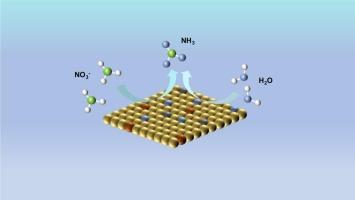Laser-induced Mo valence engineering in Cu2O enables efficient nitrate electroreduction
IF 9.7
1区 化学
Q1 CHEMISTRY, PHYSICAL
引用次数: 0
Abstract
Electrolytic nitrate reduction to ammonia (NO3−RR) offers a promising alternative to the energy-intensive Haber-Bosch process, providing a lower-energy pathway for sustainable ammonia production. Here, we report a laser-assisted strategy to modulate the valence states of molybdenum in Mo-doped Cu2O (LG-Mo-Cu2O/CF). The catalyst, synthesized via hydrothermal doping followed by laser treatment, enables Mo6+ reduction of to Mo4+. The low-valent Mo species promote H2O dissociation to generate surface-bound hydrogen (*H), thereby facilitating the hydrogenation steps of NO3−RR. At a NO3− concentration of 0.1 M, the LG-Mo-Cu2O/CF catalyst delivers excellent performance, achieving an NH3 yield of 10.9 mg h−1 cm−2 and a Faraday efficiency of 94.3 % at −0.5 V vs. RHE, along with a nitrate-to-ammonia conversion rate of 93.2 %. This work highlights the potential of laser-enabled valence engineering as an effective approach to enhance the activity and selectivity of NO3−RR electrocatalysts.

在Cu2O中激光诱导Mo价工程实现了高效的硝酸盐电还原
硝酸电解还原制氨(NO3 - RR)为能源密集型的Haber-Bosch工艺提供了一个有希望的替代方案,为可持续的氨生产提供了一个低能耗的途径。在这里,我们报告了一种激光辅助策略来调节钼掺杂Cu2O (LG-Mo-Cu2O/CF)中钼的价态。该催化剂通过水热掺杂和激光处理合成,使Mo6+还原为Mo4+。低价Mo促进H2O解离生成表面结合氢(*H),从而促进NO3−RR的加氢步骤。在NO3−浓度为0.1 M时,LG-Mo-Cu2O/CF催化剂表现优异,NH3产率为10.9 mg h−1 cm−2,与RHE相比,在−0.5 V时法拉第效率为94.3%,硝酸盐转化为氨的转化率为93.2%。这项工作强调了激光价态工程作为提高NO3−RR电催化剂活性和选择性的有效方法的潜力。
本文章由计算机程序翻译,如有差异,请以英文原文为准。
求助全文
约1分钟内获得全文
求助全文
来源期刊
CiteScore
16.10
自引率
7.10%
发文量
2568
审稿时长
2 months
期刊介绍:
The Journal of Colloid and Interface Science publishes original research findings on the fundamental principles of colloid and interface science, as well as innovative applications in various fields. The criteria for publication include impact, quality, novelty, and originality.
Emphasis:
The journal emphasizes fundamental scientific innovation within the following categories:
A.Colloidal Materials and Nanomaterials
B.Soft Colloidal and Self-Assembly Systems
C.Adsorption, Catalysis, and Electrochemistry
D.Interfacial Processes, Capillarity, and Wetting
E.Biomaterials and Nanomedicine
F.Energy Conversion and Storage, and Environmental Technologies

 求助内容:
求助内容: 应助结果提醒方式:
应助结果提醒方式:


